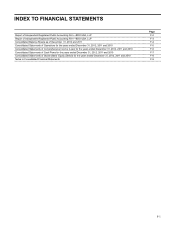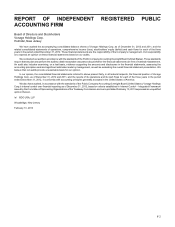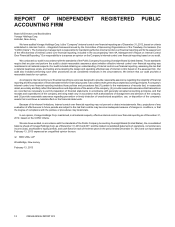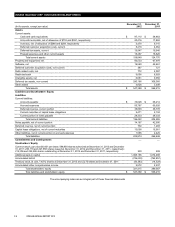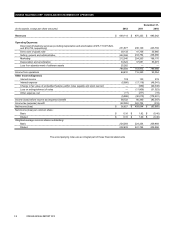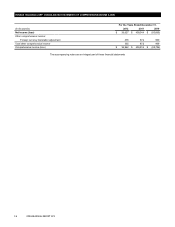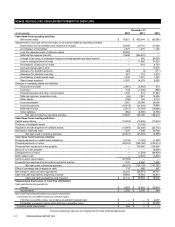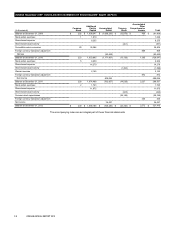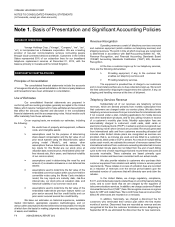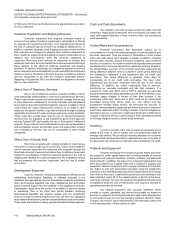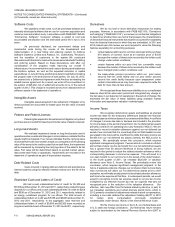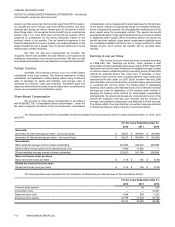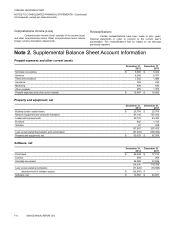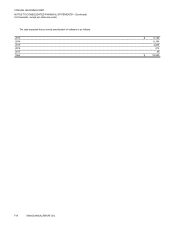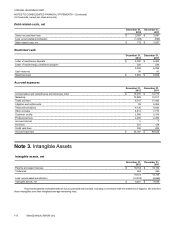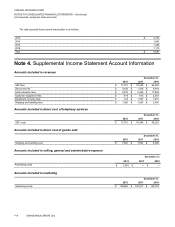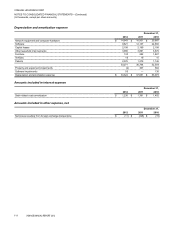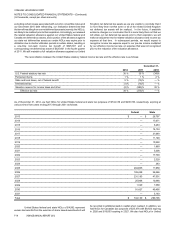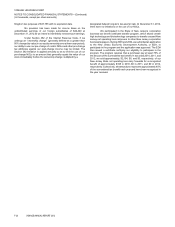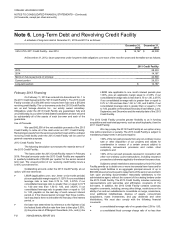Vonage 2012 Annual Report Download - page 64
Download and view the complete annual report
Please find page 64 of the 2012 Vonage annual report below. You can navigate through the pages in the report by either clicking on the pages listed below, or by using the keyword search tool below to find specific information within the annual report.F-11 VONAGE ANNUAL REPORT 2012
Software Costs
We capitalize certain costs, such as purchased software and
internally developed software that we use for customer acquisition and
customer care automation tools, in accordance with FASB ASC 350-40,
“Internal-Use Software”. Computer software is stated at cost less
accumulated amortization and the estimated useful life is two to five
years.
As previously disclosed, we experienced delays and
incremental costs during the course of the development and
implementation of a new billing and ordering system by Amdocs
Software Systems Limited and Amdocs, Inc. (collectively, "Amdocs")
and the transition of customers to the system. We conducted
discussions with Amdocs to resolve the issues associated with the billing
and ordering system. Based on these discussions, and after our
consideration of the progress made improving our overall IT
infrastructure, the incremental time and costs to develop and implement
the Amdocs system, as well as the expected reduction in capital
expenditures, in June 2012 we and Amdocs determined that terminating
the program was in the best interest of both parties. On July 30, 2012,
we entered into a Settlement Agreement with Amdocs terminating the
related license agreement. As a result, we wrote off our investment in
the system of $25,262, net of settlement amounts to us, in the second
quarter of 2012. This charge is recorded as loss from abandonment of
software assets in the statement of operations.
Intangible Assets
Intangible assets acquired in the settlement of litigation or by
direct purchase are accounted for based upon the fair value of assets
received.
Patents and Patent Licenses
Patent rights acquired in the settlement of litigation or by direct
purchase are accounted for based upon the fair value of assets received.
Long-Lived Assets
We evaluate impairment losses on long-lived assets used in
operations when events and changes in circumstances indicate that the
assets might be impaired. If our review indicates that the carrying value
of an asset will not be recoverable, based on a comparison of the carrying
value of the asset to the undiscounted future cash flows, the impairment
will be measured by comparing the carrying value of the asset to its fair
value. Fair value will be determined based on quoted market values,
discounted cash flows or appraisals. Impairments are recorded in the
statement of operations as part of depreciation expense.
Debt Related Costs
Costs incurred in raising debt are deferred and amortized as
interest expense using the effective interest method over the life of the
debt.
Restricted Cash and Letters of Credit
We had a cash collateralized letter of credit for $5,300 and
$6,300 as of December 31, 2012 and 2011, respectively, related to lease
deposits for our offices and a cash collateralized letter of credit for $258
and $536 as of December 31, 2012 and 2011, respectively, related to
an energy curtailment program for our offices. The total amount of
collateralized letters of credit was $5,558 and $6,836 at December 31,
2012 and 2011, respectively. In the aggregate, cash reserves and
collateralized letters of credit of $5,656 and $6,929 were recorded as
long-term restricted cash at December 31, 2012 and 2011, respectively.
Derivatives
We do not hold or issue derivative instruments for trading
purposes. However, in accordance with FASB ASC 815, “Derivatives
and Hedging” (“FASB ASC 815”), we review our contractual obligations
to determine whether there are terms that possess the characteristics
of derivative financial instruments that must be accounted for separately
from the financial instrument in which they are embedded. In 2011 and
2010, based upon this review, we were required to value the following
features separately for accounting purposes:
> certain features within a prior common stock warrant to purchase
514 shares of common stock at an exercise price of $0.58
because the number of shares to be received by the holder could
change under certain conditions;
> certain features within our prior third lien convertible notes
because the number of shares to be received by the holder could
have changed under certain conditions; and
> the make-whole premium provisions within our prior senior
secured first lien credit facility and our prior senior secured
second lien credit facility because upon prepayment under
certain circumstances we may have been required to settle the
debt for more than its face amount.
We recognized these features as liabilities in our consolidated
balance sheet at fair value each period and recognized any change in
the fair value in our statement of operations in the period of change. We
estimated the fair value of these liabilities using available market
information and appropriate valuation methodologies.
Income Taxes
We recognize deferred tax assets and liabilities at enacted
income tax rates for the temporary differences between the financial
reporting bases and the tax bases of our assets and liabilities. Any effects
of changes in income tax rates or tax laws are included in the provision
for income taxes in the period of enactment. Our net deferred tax assets
primarily consist of net operating loss carry forwards (“NOLs”). We are
required to record a valuation allowance against our net deferred tax
assets if we conclude that it is more likely than not that taxable income
generated in the future will be insufficient to utilize the future income tax
benefit from our net deferred tax assets (namely, the NOLs) prior to
expiration. We periodically review this conclusion, which requires
significant management judgment. If we are able to conclude in a future
period that a future income tax benefit from our net deferred tax assets
has a greater than 50 percent likelihood of being realized, we are
required in that period to reduce the related valuation allowance with a
corresponding decrease in income tax expense. This will result in a
non-cash benefit to our net income in the period of the determination.
In the fourth quarter of 2011, we released $325,601 of valuation
allowance (see Note 5. Income Taxes). We periodically review this
conclusion, which requires significant management judgment. In the
future, if available evidence changes our conclusion that it is more likely
than not that we will utilize our net deferred tax assets prior to their
expiration, we will make an adjustment to the related valuation allowance
and income tax expense at that time. In subsequent periods, we would
expect to recognize income tax expense equal to our pre-tax income
multiplied by our effective income tax rate, an expense that was not
recognized prior to the reduction of the valuation allowance. Our
effective rate may differ from the federal statutory rate due, in part, to
our Canadian operations and certain discrete period items, which in
2012 primarily consisted of adjustments related to stock compensation,
including a non-cash deferred tax adjustment totaling $4,077 in 2012
for certain stock compensation previously considered
nondeductible under Section 162(m) of the Internal Revenue Code.
We file income tax returns in the U.S. on a federal basis and
in U.S. state and foreign jurisdictions. Our federal tax return remains
subject to examination by the Internal Revenue Service from 2007 to
VONAGE HOLDINGS CORP.
NOTES TO CONSOLIDATED FINANCIAL STATEMENTS—(Continued)
(In thousands, except per share amounts)


